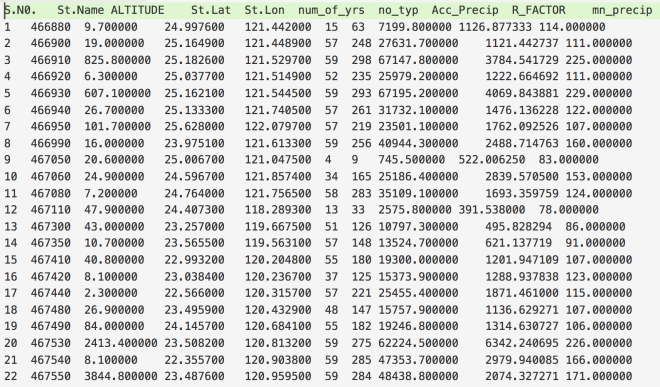In geosciences, we most frequently have to make geospatial plots, but the available data is unevenly distributed and irregular (Figure 1). We like to show the data, in general, for the whole region and one way of performing, so it to do the geospatial interpolation of the data. Geospatial interpolation means merely that we obtain the interpolated values of the data at regular grid points, both longitudinally and latitudinally. After obtaining these values, if we plot the data then the grid points is most likely to extend out of the coastline constrain of our study. We wish to plot the data inside the coastline borders of the area, which is our area of study. We can do that by just removing all the grid points outside the perimeter. One way to clip the data outside the coastline path is to manually remove the grid points outside the region, but this method is quite tedious. We, programmers, love being lazy and that helps us to seek better ways.

In this post, we aim to do (1) the interpolation of these data values using the ordinary kriging method and (2) plot the output within the coastline border of Taiwan.
For implementing the ordinary kriging interpolation, we will use the “pykrige” kriging toolkit available for Python. The package can be easily installed using the “pip” or “conda” package manager for Python.
We start by importing all the necessary modules.
import numpy as np import pandas as pd import glob from pykrige.ok import OrdinaryKriging from pykrige.kriging_tools import write_asc_grid import pykrige.kriging_tools as kt import matplotlib.pyplot as plt from mpl_toolkits.basemap import Basemap from matplotlib.colors import LinearSegmentedColormap from matplotlib.patches import Path, PathPatch

The first step for interpolation is to read the available data. Our data is of the format shown in Figure 2. Let’s say we want to interpolate for the “R_FACTOR”. We first read this data file. We can easily do that using the “pandas” in Python.
datafile='datafilename.txt' df=pd.read_csv(datafile,delimiter='\s+')
Now, we have read the whole tabular data, but we need only the “R_FACTOR”, “St.Lat”, and “St.Lon” columns.
lons=np.array(df['St.Lon']) lats=np.array(df['St.Lat']) data=np.array(df[data])
Now, we have our required data available in the three variables. We can, now, define the grid points where we seek the interpolated values.
grid_lon = np.arange(lons.min()-0.05, lons.max()+0.1, grid_space) grid_lat = np.arange(lats.min()-0.05, lats.max()+0.1, grid_space)
The minimum and maximum of the longitude and latitude are chosen based on the data.
We use the “ordinary kriging” function of “pykrige” package to interpolate our data at the defined grid points. For more details, the user can refer to the manual of the “pykrige” package.
OK = OrdinaryKriging(lons, lats, data, variogram_model='gaussian', verbose=True, enable_plotting=False,nlags=20)
z1, ss1 = OK.execute('grid', grid_lon, grid_lat)
“z1” is the interpolated values of “R_FACTOR” at the grid_lon and grid_lat values.
Now, we wish to plot the interpolated values. We will use the “basemap” module to plot the geographic data.
xintrp, yintrp = np.meshgrid(grid_lon, grid_lat)
fig, ax = plt.subplots(figsize=(10,10))
m = Basemap(llcrnrlon=lons.min()-0.1,llcrnrlat=lats.min()-0.1,urcrnrlon=lons.max()+0.1,urcrnrlat=lats.max()+0.1, projection='merc', resolution='h',area_thresh=1000.,ax=ax)
We, first, made the 2D meshgrid using the grid points and then call the basemap object “m” with the Mercator projection. The constraints of the basemap object can be manually defined instead of the minimum and maximum of the latitude and longitude values as used.
m.drawcoastlines() #draw coastlines on the map x,y=m(xintrp, yintrp) # convert the coordinates into the map scales ln,lt=m(lons,lats) cs=ax.contourf(x, y, z1, np.linspace(0, 4500, ncols),extend='both',cmap='jet') #plot the data on the map.
cbar=m.colorbar(cs,location='right',pad="7%") #plot the colorbar on the map
# draw parallels. parallels = np.arange(21.5,26.0,0.5) m.drawparallels(parallels,labels=[1,0,0,0],fontsize=14, linewidth=0.0) #Draw the latitude labels on the map # draw meridians meridians = np.arange(119.5,122.5,0.5) m.drawmeridians(meridians,labels=[0,0,0,1],fontsize=14, linewidth=0.0)

This will give us the plot of the interpolated values (Figure 3). Here, we do not seek the plot outside the coastline boundary of Taiwan. We wish to mask the data outside the boundary.
##getting the limits of the map: x0,x1 = ax.get_xlim() y0,y1 = ax.get_ylim() map_edges = np.array([[x0,y0],[x1,y0],[x1,y1],[x0,y1]])
##getting all polygons used to draw the coastlines of the map polys = [p.boundary for p in m.landpolygons] ##combining with map edges polys = [map_edges]+polys[:]
##creating a PathPatch codes = [ [Path.MOVETO]+[Path.LINETOfor p in p[1:]] for p in polys ] polys_lin = [v for p in polys for v in p] codes_lin = [c for cs in codes for c in cs] path = Path(polys_lin, codes_lin) patch = PathPatch(path,facecolor='white', lw=0)
Here, the ‘facecolor’ of the ‘pathpatch’ defines the color of the masking. We kept is ‘white,’ but the user can define any color they like.
##masking the data outside the inland of taiwan ax.add_patch(patch)
